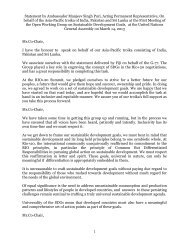STATE OF THE WORLD'S CITIES 2012/2013 Prosperity
STATE OF THE WORLD'S CITIES 2012/2013 Prosperity
STATE OF THE WORLD'S CITIES 2012/2013 Prosperity
You also want an ePaper? Increase the reach of your titles
YUMPU automatically turns print PDFs into web optimized ePapers that Google loves.
system in 2009, and when fully operational in <strong>2012</strong> is<br />
expected to reduce car use by 30 per cent. 36 In 2010, the<br />
Greater Amman Municipality launched a USD175 million<br />
Box 2.2.2<br />
Information and communication technologies (ICTs) and the <strong>Prosperity</strong> of Cities<br />
Over the past decade, worldwide expansion in ICTs has been<br />
nothing short of phenomenal. In the sole mobile telephony<br />
area, for instance, the total number of subscriptions increased<br />
from 962 million in 2001 to six billion in 2011 – resulting in a<br />
worldwide ratio of 867:1,000. 38 It is worth noting that developing<br />
countries account for over 75 per cent of global mobile cellular<br />
subscriptions. No other component of infrastructure has<br />
witnessed such spectacular growth. Advances in ICTs and<br />
liberalization of telecommunications markets have led to wealth<br />
creation and economic growth, with cities the major beneficiaries.<br />
ICTs play a major role in any city’s competitiveness, productivity<br />
and prosperity as they facilitate innovation, efficiency and<br />
effective service delivery. An overwhelming majority of surveyed<br />
experts – 85 per cent in Africa; 96 per cent in Asia; 86 per cent in<br />
Latin America and the Caribbean; and 90 per cent in Arab States –<br />
rank telecommunications infrastructure as ‘highly developed’ or<br />
‘developed’ in their cities.<br />
FACT<br />
In Africa, the total number of mobile telephone<br />
connections has grown an average 30 per cent<br />
per annum since 2001, and by 2011 over 60 per cent<br />
of the population was connected. In Asia-Pacific,<br />
the number of mobile connections increased from<br />
824 million in 2005 to three billion in 2011– making<br />
the region the largest mobile telephone market in<br />
the world. Remarkable growth rates have also been<br />
recorded in the Middle East, where the number of mobile<br />
connections increased from 177 million in 2007 to<br />
334 million in 2011. 39<br />
ICTs in African cities: Mobile telephones have leapfrogged<br />
landlines in Africa when compared with developed regions that<br />
invested in landlines before moving to mobile networks. 40 At least<br />
90 per cent of households in Abuja, Accra, Dakar, Lagos, Luanda<br />
and Nairobi own mobile telephones; even where ownership<br />
of mobile telephones appears to be low, it hardly falls below<br />
50 percent. The use of mobile telephones surpasses fixed lines<br />
in virtually all cities. In Kinshasa, there are 119 times as many<br />
households owning mobile telephones as fixed lines. In Lagos,<br />
Harare, Kampala and Mombasa, households are 12 times more<br />
likely to own mobile telephones than landlines. Apart from<br />
facilitating connectivity and communication, the cell-phone<br />
industry also serves as a catalyst for growth, contributing an<br />
55<br />
Urban Infrastructure: Bedrock of <strong>Prosperity</strong><br />
BRT project along three busy corridors totaling 32km; when<br />
completed in <strong>2012</strong>, the system will have a transport capacity<br />
of 6,000 passengers per hour. 37<br />
estimated average USD56 billion or 3.5 per cent of GDP, to the<br />
regional economy every year, 41 as well as employment for over<br />
five million Africans.<br />
ICTs in Asian cities: Mobile telephony has also expanded<br />
dramatically in this region. India’s four major cities – Delhi,<br />
Mumbai, Kolkata and Chennai – feature mobile telephone<br />
connection rates of 138 per cent, 112 per cent, 102 per cent and<br />
143 per cent respectively. 42 In Singapore, telecommunications<br />
infrastructure is highly developed. In 2010, the household fixedline<br />
penetration rate was 103 per cent, and the mobile population<br />
penetration rate was 144 per cent, with 82 per cent of households<br />
having access to Internet. 43 ICTs are major contributors to<br />
economic growth in Asia accounting for USD485 billion, or<br />
2.7 per cent of GDP; they also provide 11.4 million jobs – for<br />
each job created by a mobile operator, eight additional ones<br />
are generated. 44 The major role played by the mobile telephone<br />
sector has seen it act as a buffer against economic recession in<br />
the region.<br />
ICTs in Latin American cities: The ownership of mobile<br />
telephones is fairly widespread. Urban areas in Brazil, Chile,<br />
Panama, and Paraguay feature the highest connection rates, with<br />
at least 80 per cent of households owning mobile telephones. 45<br />
In major Mexican cities, ownership varies between 66 and<br />
84 per cent of the population. Compared with Africa and Asia,<br />
fixed lines are more developed in Latin American cities. For<br />
instance, between 41 per cent and 68 per cent of households<br />
in Mexico’s major cities have fixed lines. The mobile telephone<br />
industry contributes significantly to the region’s economy:<br />
1.7 per cent of regional GDP 46 (or USD82 billion) in 2010.<br />
Increases in mobile telephone connectivity have also been found<br />
to boost GDP per capita.<br />
ICTs in Arab States cities: Urban ownership of mobile<br />
telephones in Arab States, especially Gulf Cooperation Council<br />
countries, is widespread. Penetration rates in Doha, Dubai,<br />
Amman, Kuwait, Muscat and Riyadh are in excess 100 per cent<br />
(Dubai’s penetration rate is the highest in the world with over<br />
200 mobile telephones per 100 residents). The UAE and other Gulf<br />
Cooperation Council countries have invested in ITC-dedicated<br />
parks as a boost to socioeconomic growth and diversification<br />
away from an oil-dependent to a knowledge-based economy. The<br />
ICT sector plays a significant role in the region’s economy. In the<br />
case of the UAE, the sector contributed 5.3 per cent to GDP in<br />
2010, up from 4.1 per cent in 2007, and currently employs over<br />
11,500. 47


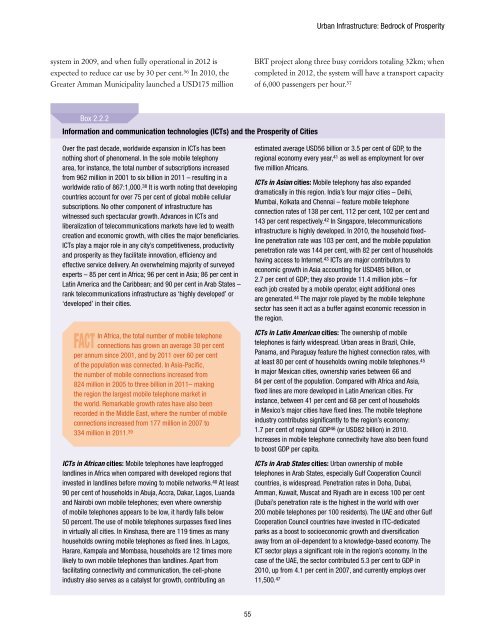

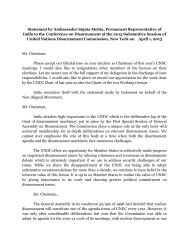


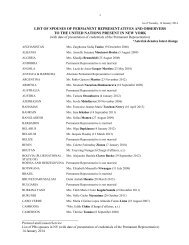
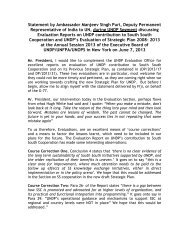




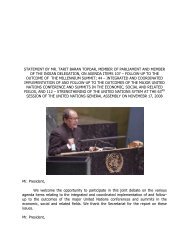
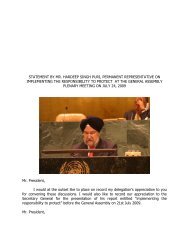
![1 statement by dr.[mrs] kakoli ghosh dastidar - Member States Portal](https://img.yumpu.com/27526598/1/190x245/1-statement-by-drmrs-kakoli-ghosh-dastidar-member-states-portal.jpg?quality=85)
